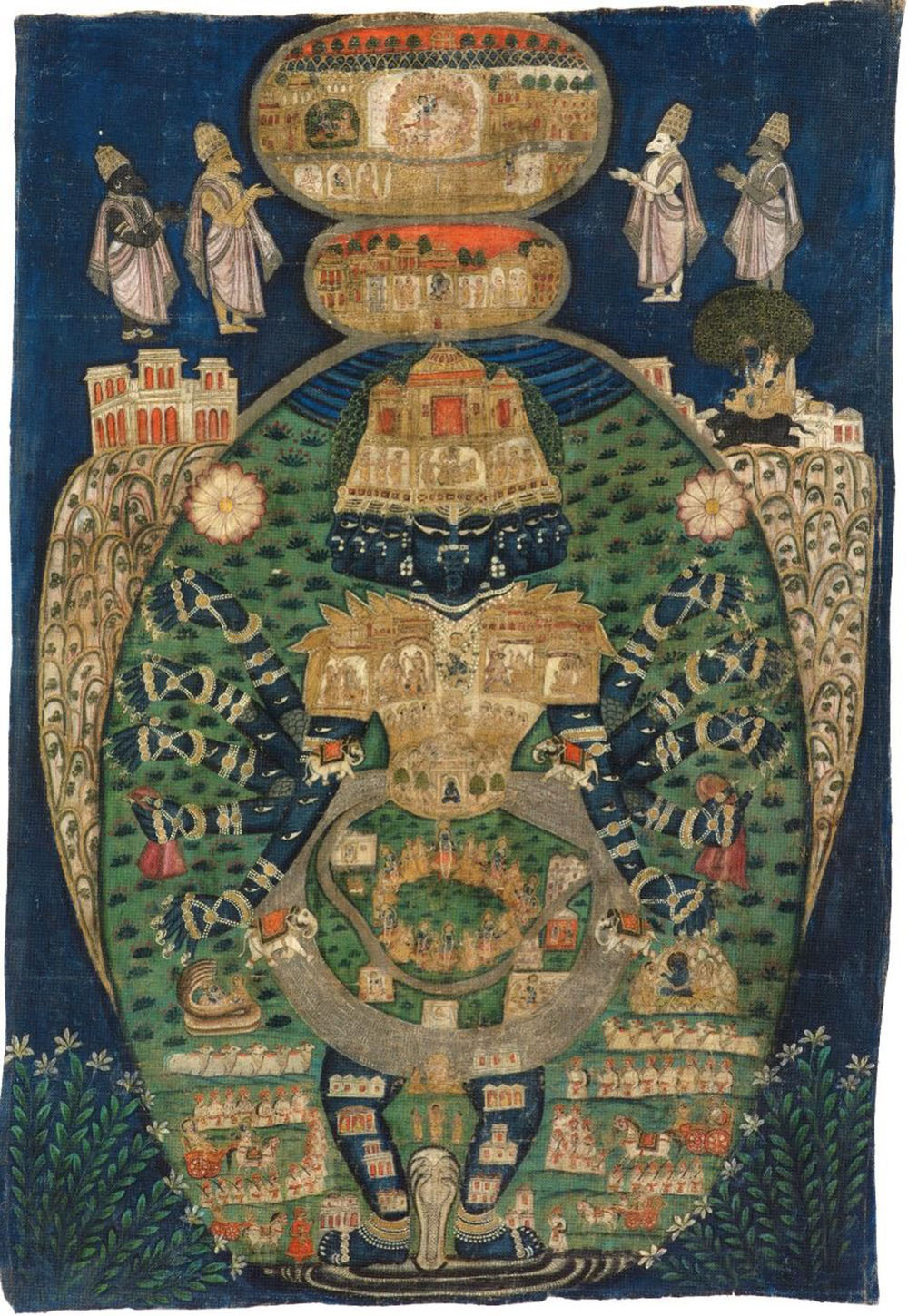
Cosmic Form of Krishna, circa 1800–1900, India; Rajasthan or Gujarat, opaque watercolors and ink on cloth, Lent by Julia Emerson, H: 52 in. W: 35 1/2 in. (132 x 90.2 cm)
Verbal Description
Hello, my name is Anu Mitra. I am docent at the Cincinnati Art Museum. I will be reading the verbal description for Cosmic Form of Krishna in Beyond Bollywood: 2000 Years of Dance in Art.
The painting, Cosmic Form of Krishna, in opaque watercolor and ink on cloth dates from around 1800 to 1900. It is from India, specifically Rajasthan or Gujarat. It was lent by Julia Emerson.
Measuring 132 by 90.2 centimeters, this portrait-oriented painting on cloth shows multiple images of the blue-skinned god Krishna and the gopis or cowherd women who dance with him. One immense form of Krishna fills a large vertical oval shape that dominates the painting. Outside the oval is a midnight blue background; inside the oval, the ground is a lush green.
This large Krishna has ten blue bejeweled arms dotted with eyes arrayed symmetrically on either side of his body. The jeweled hands reach outward with long relaxed fingers. One the tips of all his fingers are animal heads; most look like cows, others appear to be deer, and some look like elephants. He has multiple heads surmounted by an elaborate gold crown which houses a tiny scene of a god, likely Brahma, being honored by several devotees. Fields, rivers, mountains, temples, and palaces are arrayed on his torso and legs. Over the large Krishna’s head on top of the vertical oval are two horizontal ovals with smaller scenes inside. Inside the smaller oval is a scene of Krishna seated in a palace flanked by worshippers.
The circle dance of Krishna with the gopis is seen twice: one is in the very top oval. Here, a single form of Krishna occupies the center, and gopis dressed in gold garments ring him. The other is at the pelvis of the monumental Krishna. Here one larger Krishna stands at the top of the circle, and smaller Krishnas alternate with gopis around the circle, all these figures are lavishly dressed and jeweled. On either side of the monumental Krishna’s legs are rows of figures in white garments and saffron colored turbans. They symbolize two opposing armies and reference the battlefield in the epic Mahabharata. Four adorned white elephants encircle the monumental Krishna’s pelvis.
Label Text
Hello, my name is Anu Mitra. I am docent at the Cincinnati Art Museum. I will be reading the label for Cosmic Form of Krishna in Beyond Bollywood: 2000 Years of Dance in Art.
The painting, Cosmic Form of Krishna, in opaque watercolor and ink on cloth dates from around 1800 to 1900. It is from India, specifically Rajasthan or Gujarat. It was lent by Julia Emerson.
For those who worship him, Krishna is the Supreme Being, encompassing every aspect of the universe. In a famous passage of the great Hindu epic the Mahabharata, Krishna allows the hero Arjuna to see him in his transcendent form. Devotees may also see Krishna in his true form through meditation and visualization.
Here, the immense form of the supreme Krishna looms into space. The circle dance with the cowherd women is shown twice: on Krishna’s lower body and again, far above, in his heaven. This reminds the devotee that the dance of divine love takes place eternally in this celestial realm, while the earthly version happens at a particular moment and place.
